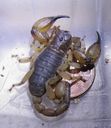Anuroctonus
Anuroctonus
Classification
- Phylum: Arthropoda
- Subphylum: Chelicerata
- Class: Arachnida
- Order: Scorpiones
- Family: Iuridae
- Genus: Anuroctonus
Pronunciation
How to pronounce Anuroctonus: /ˌænjuˈrɒktənəs/
These audio files are automatically generated. While they are not always 100% accurate, they are a good starting point.
Images






Summary
Anuroctonus pococki, the California swollen-stinger scorpion, is a large, mildly venomous scorpion native to Southern California and Baja California. Recognizable by their swollen stingers and black-tipped claws, they are nocturnal ambush predators that dig substantial burrows for hunting.
Physical Characteristics
Large scorpion measuring up to 65 mm (2.6 in) with very large, black-tipped claws and a swollen region just before the stinger on their telsons, especially prominent in mature males.
Identification Tips
Look for the swollen stinger before the telson and large black-tipped claws; they are larger in size compared to other local scorpions.
Habitat
Coast ranges of Southern California and Baja California, living in burrows dug by females up to 60 cm deep.
Distribution
Native to Southern California and Baja California in North America; the only scorpion from the genus Anuroctonus found in Baja California.
Diet
Ambush predator, primarily preying on insects that wander near their burrows.
Life Cycle
Information on the specific life cycle is not provided; generally, scorpions have a life cycle involving egg, juvenile, and adult stages.
Reproduction
Females dig deeper burrows, while males create shallower burrows; mating behavior is typical for scorpions.
Ecosystem Role
Predators of insects, helping to control insect populations in their environment.
Cultural Significance
The species may hold significance in studies of arachnology and local ecology, due to its unique adaptations.
Health Concerns
Stings are painful but typically non-serious, resolving after 24 hours; possible serious health risks for very young or old individuals; professional medical attention is advised for scorpion stings.
Similar Taxa
- Arizona bark scorpion
Misconceptions
Stings may cause unnecessary alarm as they are usually non-serious; people may mistakenly believe all scorpions are highly venomous.
Tags
- scorpion
- Anuroctonus
- Arachnida
- venomous
- predator